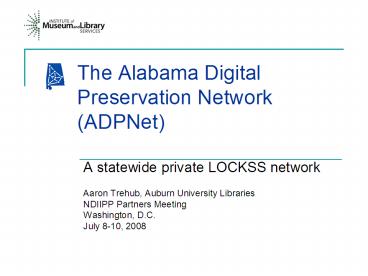The Alabama Digital Preservation Network ADPNet - PowerPoint PPT Presentation
1 / 15
Title:
The Alabama Digital Preservation Network ADPNet
Description:
To create a low-cost, low-maintenance, sustainable, geographically distributed ... at Alabama Library Association, Best Practices Exchange, and LITA national forum ... – PowerPoint PPT presentation
Number of Views:79
Avg rating:3.0/5.0
Title: The Alabama Digital Preservation Network ADPNet
1
The Alabama Digital Preservation Network
(ADPNet)
- A statewide private LOCKSS network
- Aaron Trehub, Auburn University Libraries
- NDIIPP Partners Meeting
- Washington, D.C.
- July 8-10, 2008
2
Objective
- To create a low-cost, low-maintenance,
sustainable, geographically distributed digital
preservation network for libraries, archives, and
museums in Alabama.
3
Background
- ADPNet inspired by Auburns experience with
Library of Congress-funded NDIIPP MetaArchive
Project - ADPNet supported by an IMLS grant September 2006
through September 2008 - Grant awarded to and administered by Alabama
Council on Higher Education/Network of Alabama
Academic Libraries in Montgomery - Project director at Auburn University Libraries
- Commitments from seven institutions across the
state
4
The seven participating institutions
- Alabama Dept. of Archives and History
(Montgomery, AL) - Auburn University (Auburn, AL)
- Spring Hill College (Mobile, AL)
- Troy University (Troy, AL)
- University of Alabama (Tuscaloosa, AL)
- University of Alabama at Birmingham
- University of North Alabama (Florence, AL)
5
The network
- ADPNet is a Private LOCKSS Network (PLN)
- Dark archive for preservation ONLY, not access
or display - Uses off-the-shelf equipment and software
- LOCKSS servers (nodes) at all seven
participating institutions - Each institution maintains its LOCKSS server
- Each institution contributes content for
harvesting and archiving by the network - Runs on sweat equity, with help from LOCKSS staff
6
Why Alabama?
- Hurricanes
- Tornadoes
- Growing number of rich digital collections (e.g.
AlabamaMosaic) - Modest financial resources
- Uneven technical support
- Ideal test case for geographically distributed
digital preservation network
7
Why LOCKSS?
- Familiar with it (through the NDIIPP MetaArchive
project) - Simple and robust
- Cheap (except for membership in LOCKSS
Alliancemore on that later) - Excellent technical support
- Know it works
8
Costs
- Servers LOCKSS server and Web server (for making
content available to the network) - Staff time less than we anticipated
- Communication e-mail listserv, weekly conference
calls, some meetings - Some travel mostly in-state
- The biggie annual LOCKSS Alliance membership
fee. Supports LOCKSS software development and
technical support
9
ADPNet cached content
- ADPNet currently contains 35 collections
(archival units) from five of the seven member
institutions - Approximately 250 gigabytes harvested
- Network capacity one terabyte, soon to be upped
to 1.5 terabytes - Plenty of room for more collections
- More collections on the way, including audio and
video files
10
ADPNet administration
- ADPNet is a single-state network
- Folded into existing administrative
infrastructure Alabama Commission on Higher
Education/Network of Alabama Academic Libraries
(NAAL) - Not a service organization
- No membership feesbut LOCKSS Alliance membership
mandatory - In-kind contribution bring up and run a LOCKSS
node in the networkwith exception for smaller
institutions - Governance document in the works
11
ADPNet digital preservation
awareness survey
- Sent to academic and public libraries, archives,
schools, and state and municipal offices in
Alabama in February 2008 - 79 responses public libraries largest single
group of respondents - Most important decision factors reliability (91
percent), expertise and support (88 percent),
cost (86 percent), staffing (84 percent), and
preservation of mission-critical collections (84
percent) - Most people learn about new initiatives from
conferences and colleagues, so focus on those
12
Achievements
- ADPNet is the first single-state private LOCKSS
network in the U.S. - Appears to be serving as a model for other states
and consortia - Similar networks being built by the Arizona State
Library and a consortium of Canadian academic
libraries - Presentations at Alabama Library Association,
Best Practices Exchange, and LITA national forum
13
Lessons learned
- Keep it simple
- Keep it cheap
- Dont get fancy
- Aim for low maintenance and low administrative
overhead - Take advantage of existing structures and
relationships (easier to do with a single-state
network)
14
The future
- Add more content to the network
- Recruit more member institutions, including
public libraries, museums, and other cultural
heritage organizations - Develop partnerships with other PLNs
- Spread the word
15
- For more information
- ADPNet http//adpn.org/
- LOCKSS http//www.lockss.org/
- MetaArchive http//www.metaarchive.org/
- Aaron Trehub
- Auburn University Libraries
- trehuaj_at_auburn.edu
- (334) 844-1716































